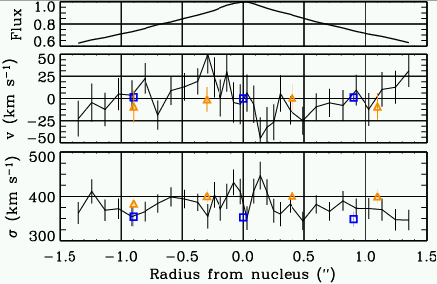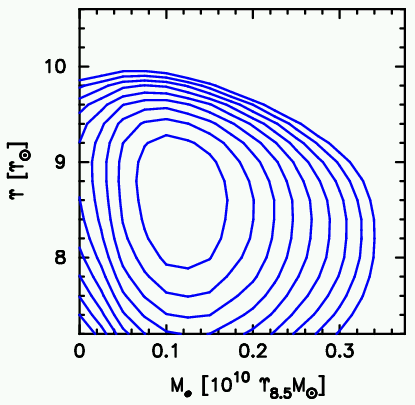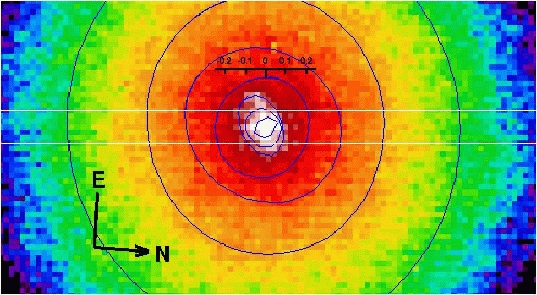Demographic Limitations of SMBHs
The universality of this relationship, however, is not yet
established. Of the 31 MBH measurements
listed in the compilation of Tremaine et al. (2002), 18 are for
ellipticals, 9 for lenticulars, and 4 for spirals (Figure
1). The MBH~sigma relation is therefore
still based on a limited sample of galaxies, biased towards
early types. Several questions remain unanswered. Is the
relation the same for ellipticals and spirals? Does it hold for
all disk galaxies, barred and unbarred?
Furthermore, what is the intrinsic scatter of the relation?
Clearly, the tighter the MBH~sigma
relation the greater the challenge for theorists and the
greater its usefulness as an MBH
estimator. Even the slope of the MBH~sigma relation is still disputed (Ferrarese
& Ford 2004).
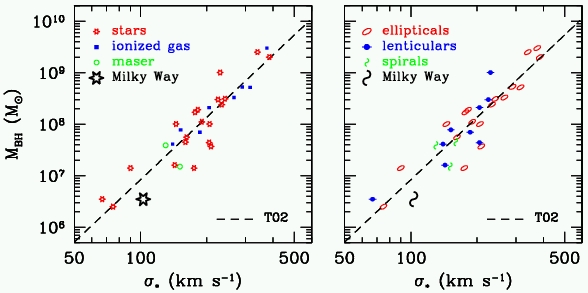
|
| Figure 1: The MBH~sigma relation (dashed line, according to Tremaine et al. (2002), along with the MBH measurements usedto derive it, coded according to the adopted tracer for the gravitational potential (left) or to the different type of SMBHs host galaxies (right). Notice the shortage of galaxies at both end of the MBH~sigma relation. |
Underlying Reasons of these Limitations
There is a simple reason why the sample of galaxies with good MBH measurements is small and biased. In order to measure MBH reliably, one needs to be able to resolve the kinematics of stars or gas on spatial scales DBH~2GMBH/sigma2, a crude estimate of the diameter of the SMBH's sphere of influence. Even for reasonably massive SMBHs in nearby galaxies DBH is a few tenths of an arcsec, so that almost all existing measurements of MBH rely on kinematics obtained from the Hubble Space Telescope (HST). HST, however, is a 2.4m telescope, making it prohibitive to obtain high-S/N stellar kinematics of the relatively dim central regions of giant ellipticals (e.g. Ferrarese 2003). It has no near-IR spectroscopic facilities to probe the dusty nuclear regions of spiral galaxies (e.g. Carollo et al. 1997). These problems could be circumvented by using the gas kinematics, although not all galaxies have central emission and even when present, gas very rarely show clean circular disk-like motions (Sarzi et al., 2001; Ho et al., 2002).
Given the limitations of HST and that gas kinematics is
seldom regular, it is not surprising that the current SMBH
census is deficient in galaxies with MBH≤5x107Msun
(most likely to be in dusty spiral bulges) and MBH≥109Msun
(only possible with HST if there is a clean gas disk). With such
short leverage in sigma, it is clear why the slope of the MBH~sigma relation has not yet been firmly
established.
The long-awaited advent of adaptive-optics assisted near-IR
spectroscopic facilities on 8m-class telescopes (e.g.
NAOS-CONICA
and
SINFONI
at VLT; and
NIRI-ALTAIR
at Gemini), finally gave us the opportunity to complete once
and for all the SMBHs census in nearby galaxies.
For adaptive-optics correction to work, however, it is
necessary to have a bright reference point-source very close to
the science target. Until very recently this was only possible by using natural
guide stars. Unfortunately, this considerably limits the number
of potential targets, since only for very few galaxies there is
a sufficiently bright star in the Milky Way that happen to be,
in projection, close enough to galaxy nucleus.
The ability to correct for the atmospheric turbulence and
reach spatial resolution similar to HST, combined with the
larger collecting power of ground-based telescopes and near-IR
spectrographs, indeed makes it possible to measure MBH in precisely the kinds of galaxies that are
currently underrepresented in the MBH~sigma relation, namely giant ellipticals and
spiral galaxies.
To search for reference stars we have have both searched
the HST archive and cross-correlated the all-sky 2MASS point and
extended source catalogues.
The 2MASS survey provides near-IR images to compute exposure
times, wherase the HST images let us to check for
central isophote twists indicating triaxial structures that
would complicate the interpretation and to xplore our MBH sensitivity limit.
We have already identified sufficient targets to probe
both extremes of the MBH~sigma relation,
and Figure 2 shows our five best targets from the HST
archive selection only. Figure 2 also shows their position in
the MBH~sigma plane.
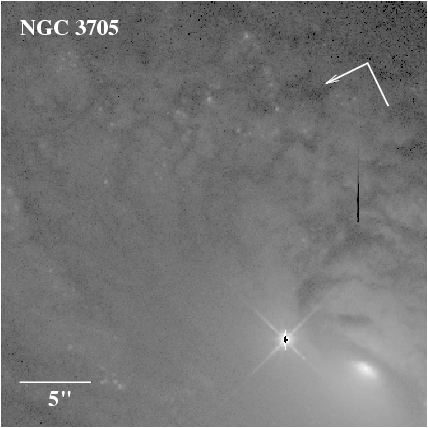
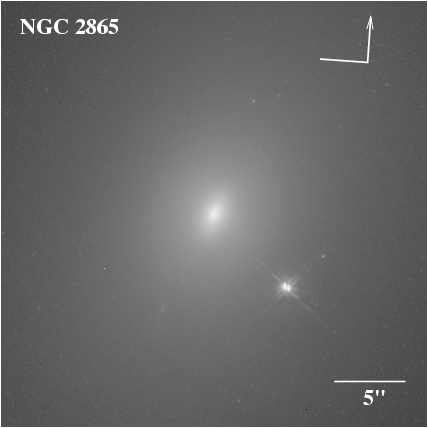
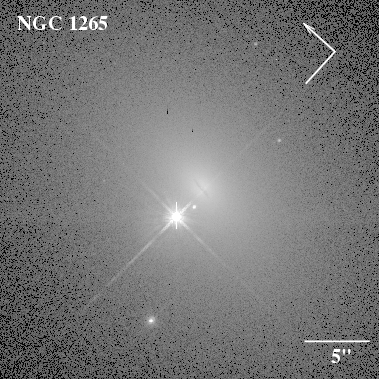
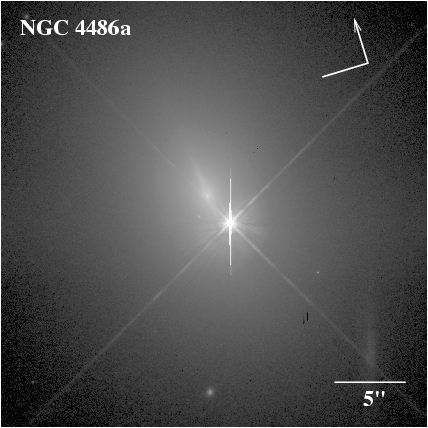
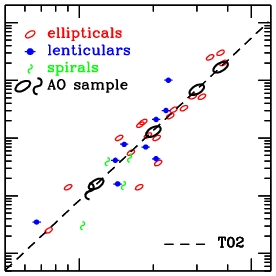
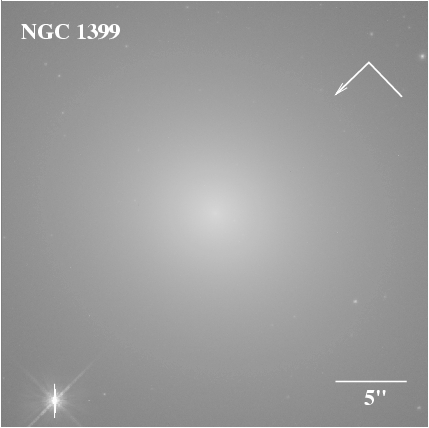
Figure 2: HST images of our 5 best AO
targets, and their position in the the MBH~sigma plane, should they follow
exactly the MBH~sigma relation
(central plot).
With VLT, we have already observed the giant elliptical NGC1399,
and are in the process of completing our observations for the
spiral NGC3705 and the lenticular NGC2865, which were severely
hampered by bad weather conditions.
With Gemini we have also started to observe the other giant
elliptical in our sample, NGC1265. Figure 3 shows, quite
spectacularly, how well the NIRI-Altair near-IR image compares
to HST images at shorter wavelengths,
The quality of the AO correction can be appreciated by noticing
the similar witdh of the reference stars in both images.
Note also how in the near-IR the nucleus of this galaxy is more
clearly visible, due to a much reduced dust attenuation.
See also this
web-page
for a preliminary analysis of these data.
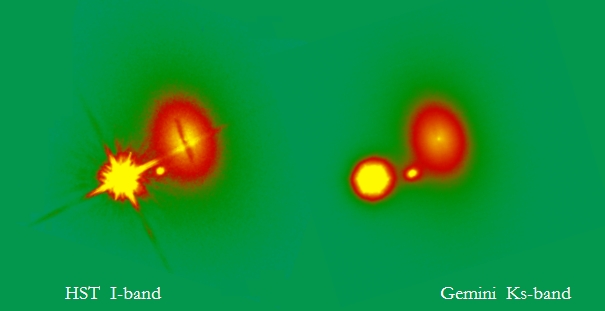
|
| Figure 3: Gemini AO-corrected NIRI-Altair Ks-band image (right) compared with an I-band HST WFPC2 image. The two images should have a comparable spatial resolution given than Gemini is larger than HST but that the NIRI-Altair images were taken at a longer wavelength than the WFPC2 images. |
A Nuclear Eccentric Disk in NGC1399?
A 1.2x109 Msun SMBH in NGC1399
In Houghton et al. (2006) we have recently published our
NACO AO-assisted observations for the central stellar
kinematics of NGC1399 and, using state-of-the-art modelling
techniques, detected a 1.2x109 Msun SMBH. This is an unprecedented achievement
in an external galaxy.
Figure 4 and 5 show, respectively, the NACO kinematics in the
very central regions of NGC1399 and the confidence level for
stellar mass-to-light ratio and MBH, the
only parameters in our dynamical models.
Furthermore, the MBH we found for
NGC1399 is consistent with the expectation of the MBH-sigma relation, at the very high-values end of
the MBH-sigma plane.
A Nuclear Eccentric Disk in NGC1399?
Our data also revealed the presence of an intriguing
elongated nuclear structure (Figure 6).
The observed feature is unlikely to be a double nucleus
resulting from the presence of a black-hole binary
(BHB). Dynamical friction causes a BHB to harden and reach an
unresolvable separation relatively quickly (in 106
- 107 yr, Milosavljević & Merritt 2001),
implying that in NGC1399 we would have catched the BHB
evolution at a very special time.
The possibility of a nuclear bar can also rejected, bearing in
mind that bars are quickly destroyed by central mass
concentrations (in few dynamical time-scales, Hasan & Norman
1990) and that the observed structure is deeply embedded in
the SMBH sphere of influence (r~0.''3).
Instead, the flat structure of Figure 6 is more likely to be an
eccentric disk, since the structure is elongated
preferentially towards one direction (SE) and because
eccentric disks can survive only in a Keplerian
potential (Tremaine 1995).
The presence of an eccentric disk is also supported by the
finding in our NAOS-CONICA data of two kinematical signatures
of a dynamically cold structure, a central decrease of the
velocity dispersion and a central velocity gradient (Figure
4).
Despite these indications, the quality of our NACO image is
admittedly poor, since it was taken in only 40s. To confirm the
presence of a nuclear eccentric disk we have recently been
awarded VLT time.
The finding of a nuclear eccentric disk in a giant
elliptical like NGC1399 could be a very important result.
Nuclear eccentric disks could be a very common feature in the
nuclei of early-type galaxies (Lauer et al. 2005). Their
presence, combined with a limited spatial resolution, could
indeed explain the finding that a considerable fraction of
galaxies host off-centered nuclei.
Yet, only one nuclear eccentric disk has so far been
found, in our closest galactic neighbour the Andromeda galaxy.
The elongated structure observed in Figure 6 could therefore
be the first eccentric disk ever found in an early-type galaxy
like NGC1399, and support the claim of Lauer et al.
Furthemore the finding of an eccentric disk will allow to
obtain an independent constraint on MBH,
as in the case of M31 (Peiris & Tremaine 2003; Salow & Statler
2004), which will be very important for a galaxy like NGC1399
that is sitting in a rather extreme position of the MBH-sigma plane plane.
Telescope Time Allocated to our Program
- VLT - 26h, ESO 072B-0763, Measuring Black-Hole Masses using NAOS-CONICA , P.I. Davies
- VLT - 34h, ESO 074.B-0513, Measuring Black-Hole Masses using NAOS-CONICA , P.I. Sarzi
- Gemini-N - 28h, G/2004B/071, Measuring Black-Hole Masses using Altair-NIRI , P.I. Sarzi
- VLT - 22h, ESO 076.B-0720, Measuring Black-Hole Masses in Spiral Galaxies using NAOS-CONICA , P.I. Davies
- VLT - 17h, ESO 076.B-0885, Stars versus Gas: A direct comparison of black hole masses measurement techniques , P.I. Sarzi
- VLT - 1h, DDT 276.B-5005, Imaging the nuclear eccentric disk of NGC~1399, P.I. Davies
- VLT - 7.5h, ESO 078.B-0806, Imaging eccentric discs in core elliptical galaxies, P.I. Houghton
Collaborators in this project are Roger Davies, Niranjan Thatte, Ryan Houghton, John Magorrian, Davor Krajnović, James Binney (Oxford), Marc Sarzi (Hertfordshire), and also Tim de Zeeuw and Michele Cappellari (Leiden).
References
- Carollo, C., Stiavelli, M., de Zeeuw, P., & Mack, J., 1997, AJ, 114, 2366
- de Zeeuw, T, 2004, Coevolution of Black Holes and Galaxies, from the Carnegie Observatories Centennial Symposia. Carnegie Observatories Astrophysics Series. Edited by L. C. Ho, 2004. Pasadena: Carnegie Observatories.
- Ferrarese, L., & Merritt, D., 2000, ApJ, 539, L9
- Ferrarese, L. 2003, ASP Conf. Ser. 291: Hubble's Science Legacy: Future Optical/Ultraviolet Astronomy from Space, 291, 196
- Ferrarese, L., & Ford, H. 2005, Space Science Reviews, 116, 523
- Gebhardt, K., et al., 2000, ApJ, 539, L13
- Graham, A., Colless, M., Busarello, G., Zaggia, S., & Longo, G. 1998, A&AS, 133, 325
- Haenelt, M. & Kauffmann, G. 2000, MNRAS, 318, 35
- Hasan, H. & Norman,C. 1990, ApJ, 361, 69
- Ho, L., Sarzi, M., Rix, H.-W., Shields, J.C., Rudnick, G., Filippenko, A., & Sargent, W, 2002, PASP, 114, 137
- Houghton, R., Magorrian, J., Sarzi, M., Thatte, N., Davies, R., Krajnović, D., 2005, MNRAS, 367, 2
- Kormendy, J. & Kennicutt, R. 2004, ARA&A, 42, 603
- Lauer, T., et al. 2005, AJ, 129, 2138
- Longo, G., Zaggia, S., Busarello, G., & Richter, G. 1994, A&AS, 105, 433
- Milosavljević, M. & Merritt, D. 2001, ApJ, 563, 34
- Peiris, H. & Tremaine, S. 2003, ApJ, 599, 237
- Salow, R. & Statler, T., 2004, ApJ, 611, 245
- Sarzi, M., Rix, H.-W., Shields, J., Rudnick, G., Ho, L., McIntosh, D., Filippenko, A., & Sargent, W, 2001, ApJ, 550, 65
- Tremaine, S. 1995, AJ, 110, 628
- Tremaine, S., et al. 2002, ApJ, 574, 740
Back home
Last modified: Mon Jul 24 10:26:33 GMT 2005
